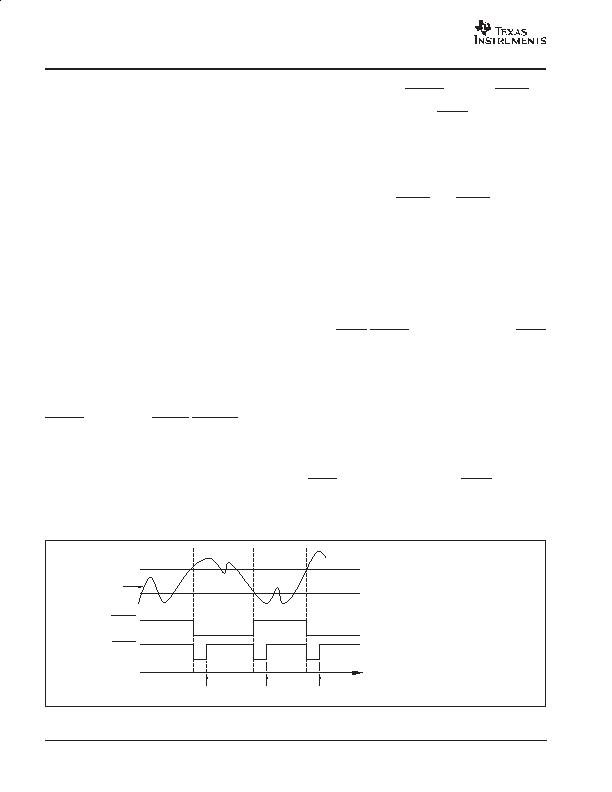
TMP401
SBOS371A AUGUST 2006 REVISED OCTOBER 2007
www.ti.com
18
HIGH-SPEED MODE
In order for the Two-Wire bus to operate at frequencies
above 400kHz, the master device must issue a
High-speed mode (Hs-mode) master code (00001XXX) as
the first byte after a START condition to switch the bus to
high-speed operation. The TMP401 will not acknowledge
this byte, but will switch the input filters on SDA and SCL
and the output filter on SDA to operate in Hs-mode,
allowing transfers at up to 3.4MHz. After the Hs-mode
master code has been issued, the master will transmit a
Two-Wire slave address to initiate a data transfer
operation. The bus will continue to operate in Hs-mode
until a STOP condition occurs on the bus. Upon receiving
the STOP condition, the TMP401 switches the input and
output filter back to fast-mode operation.
TIMEOUT FUNCTION
When bit 7 of the Consecutive Alert Register is set high,
the TMP401 timeout function is enabled. The TMP401
resets the serial interface if either SCL or SDA are held low
for 30ms (typ) between a START and STOP condition. If
the TMP401 is holding the bus low, it releases the bus and
waits for a START condition. To avoid activating the
timeout function, it is necessary to maintain a
communication speed of at least 1kHz for the SCL
operating frequency. The default state of the timeout
function is enabled (bit 7 = high).
THERM
(PIN 4) AND ALERT
/THERM2
(PIN 6)
The TMP401 has two pins dedicated to alarm functions,
the THERM
and ALERT
/THERM2
pins. Both pins are
open-drain outputs that each require a pull-up resistor to
V+. These pins can be wire-ORed together with other
alarm pins for system monitoring of multiple sensors. The
THERM
pin provides a thermal interrupt that cannot be
software disabled. The ALERT
pin is intended for use as
an earlier warning interrupt, and can be software disabled,
or masked. The ALERT
/THERM2
pin can also be
configured for use as THERM2
, a second THERM
pin
(Configuration Register: AL/TH bit = 1). The default setting
configures pin 6 to function as ALERT
(AL/TH = 0).
The THERM
pin asserts low when either the measured
local or remote temperature is outside of the temperature
range programmed in the corresponding Local/Remote
THERM Limit Register. The THERM temperature limit
range can be programmed with a wider range than that of
the limit registers, which allows ALERT
to provide an
earlier warning than THERM
. The THERM
alarm resets
automatically when the measured temperature returns to
within the THERM temperature limit range minus the
hysteresis value stored in the THERM Hysteresis
Register. The allowable values of hysteresis are shown in
Table 9. The default hysteresis is 10癈. When the
ALERT
/THERM2
pin is configured as a second thermal
alarm (Configuration Register: bit 7 = 0, bit 5 = 1), it
functions the same as THERM
, but uses the temperatures
stored in the Local/Remote Temperature High/Low Limit
Registers to set its comparison range.
When ALERT
/THERM2
(pin 6) is configured as ALERT
(Configuration Register: bit 7 = 0, bit 5 = 0), the pin asserts
low when either the measured local or remote temperature
violates the range limit set by the corresponding
Local/Remote Temperature High/Low Limit Registers.
This alert function can be configured to assert only if the
range is violated a specified number of consecutive times
(1, 2, 3, or 4). The consecutive violation limit is set in the
Consecutive Alert Register. False alerts that occur as a
result of environmental noise can be prevented by
requiring consecutive faults. ALERT
also asserts low if the
remote temperature sensor is open-circuit. When the
MASK function is enabled (Configuration Register: bit 7 = 1),
ALERT
is disabled (that is, masked). ALERT
resets when
the master reads the device address, as long as the
condition that caused the alert no longer persists, and the
Status Register has been reset.
Measured
Temperature
THERM Limit and ALERT High Limit
ALERT Low Limit and THERM Limit Hysteresis
THERM
ALERT
SMBus ALERT
Read
Read
Time
Read
Figure 17. SMBus Alert Timing Diagram
发布紧急采购,3分钟左右您将得到回复。
相关PDF资料
TPS2346PWRG4
IC HOT SWAP POWER MGR 24-TSSOP
TPS24711DGSR
IC CTRLR HOT SWAP 2.5-18V 10MSOP
TPS2491DGSG4
IC POS HV HOT-SWAP CTRLR 10-MSOP
W83772G
IC H/W MONITOR 8-TSSOP
W83L786G
IC H/W MONITOR 28-SSOP
X96011V14IZ
IC SENSOR TEMP BIAS SGL 14-TSSOP
XR4151CP-F
IC CONV VF/FV 8PDIP
XRP7714ILB-0X14-F
IC REG 5OUT BCK/LINEAR 40TQFN
相关代理商/技术参数
TMP411
制造商:BB 制造商全称:BB 功能描述:【1C Remote and Local TEMPERATURE SENSOR with N-Factor and Series Resistance Correction
TMP411_07
制造商:BB 制造商全称:BB 功能描述:【1∑C Remote and Local TEMPERATURE SENSOR with N-Factor and Series Resistance Correction
TMP411_13
制造商:TI 制造商全称:Texas Instruments 功能描述:?±1?°C Remote and Local TEMPERATURE SENSOR with N-Factor and Series Resistance Correction
TMP411A
制造商:BB 制造商全称:BB 功能描述:【1∑C Remote and Local TEMPERATURE SENSOR with N-Factor and Series Resistance Correction
TMP411AD
功能描述:板上安装温度传感器 +/-1degC Remote and Local Temp SENSOR
RoHS:否 制造商:Omron Electronics 输出类型:Digital 配置: 准确性:+/- 1.5 C, +/- 3 C 温度阈值: 数字输出 - 总线接口:2-Wire, I2C, SMBus 电源电压-最大:5.5 V 电源电压-最小:4.5 V 最大工作温度:+ 50 C 最小工作温度:0 C 关闭: 安装风格: 封装 / 箱体: 设备功能:Temperature and Humidity Sensor
TMP411ADG4
功能描述:板上安装温度传感器 Remote & Local Temp SENSOR
RoHS:否 制造商:Omron Electronics 输出类型:Digital 配置: 准确性:+/- 1.5 C, +/- 3 C 温度阈值: 数字输出 - 总线接口:2-Wire, I2C, SMBus 电源电压-最大:5.5 V 电源电压-最小:4.5 V 最大工作温度:+ 50 C 最小工作温度:0 C 关闭: 安装风格: 封装 / 箱体: 设备功能:Temperature and Humidity Sensor
TMP411ADGKR
功能描述:板上安装温度传感器 +/-1degC Remote and Local RoHS:否 制造商:Omron Electronics 输出类型:Digital 配置: 准确性:+/- 1.5 C, +/- 3 C 温度阈值: 数字输出 - 总线接口:2-Wire, I2C, SMBus 电源电压-最大:5.5 V 电源电压-最小:4.5 V 最大工作温度:+ 50 C 最小工作温度:0 C 关闭: 安装风格: 封装 / 箱体: 设备功能:Temperature and Humidity Sensor
TMP411ADGKRG4
功能描述:板上安装温度传感器 +/-1degC Remote and Local
RoHS:否 制造商:Omron Electronics 输出类型:Digital 配置: 准确性:+/- 1.5 C, +/- 3 C 温度阈值: 数字输出 - 总线接口:2-Wire, I2C, SMBus 电源电压-最大:5.5 V 电源电压-最小:4.5 V 最大工作温度:+ 50 C 最小工作温度:0 C 关闭: 安装风格: 封装 / 箱体: 设备功能:Temperature and Humidity Sensor